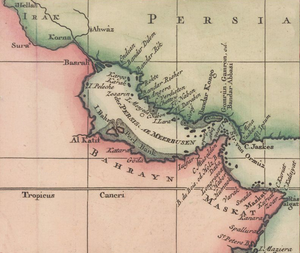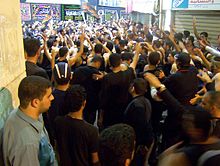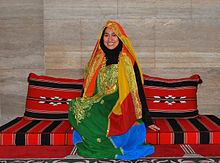Baharna: Difference between revisions
m →Bet Qatraye: TypoScan Project, typos fixed: , → , (6) using AWB |
Bet Qartay was in Mesoptamia, an area which was inhabited by the Bahranis who lived in east Arabia |
||
| Line 20: | Line 20: | ||
[[File:Bellin - Karte von der Küste von Arabien c.1745 (crop).png|thumb|right|300px|The historical region of Bahrain on a 1745 [[Jacques-Nicolas Bellin|Bellin]] map.]] |
[[File:Bellin - Karte von der Küste von Arabien c.1745 (crop).png|thumb|right|300px|The historical region of Bahrain on a 1745 [[Jacques-Nicolas Bellin|Bellin]] map.]] |
||
===Bet Qatraye=== |
|||
Bet qatraye sometimes also called (the isles) was the ecclesiastical province Kuwait, eastern Saudi Arabia, Bahrain and Qatar several Christian settlements, both monasteries and churches, and have now been found within the province, including two in Kuwait, two more in Saudi Arabia, and at least one in Qatar<ref>peter hellyer. ''[http://www.adias-uae.com/publications/hellyer01b.pdf Nestorian Christianity in the Pre-Islamic UAE and Southeastern Arabia,peter hellyer,journal of social affairs, volume 18 .number 72 .winter 2011, p. 88.</ref> |
|||
By the fifth century the [[historical region of Bahrain|Bet Qatraye]] was a major centre for [[Nestorian Christianity]] (which had come to dominate the southern shores of the Persian Gulf), with [[Samahij]]<ref>From Persian sa-mahij (سه ماهی) meaning Three Fish.</ref> being the seat of bishops. It was a center of Nestorian Christianity until al-Bahrain adopted Islam in 629 AD.<ref>Curtis E. Larsen. Life and Land Use on the Bahrain Islands: The Geoarchaeology of an Ancient Society University Of Chicago Press, 1984.</ref> As a sect, the Nestorians were often persecuted as heretics by the [[Byzantine Empire]], but Bahrain was outside the Empire's control offering some safety. The names of several of [[Muharraq Island]]’s villages today reflect this Christian legacy, with [[Al Dair]] meaning “the monastery” or "the parish." |
|||
In 410, according to the Oriental Syriac Church synodal records, a bishop named Batai was [[Excommunication|excommunicated]] from the church in Bahrain.<ref>Jean Francois Salles, p. 132.</ref>It was also the site Bahrain of worship of a shark deity called [[Awal]]. Worshippers reputedly built a large statue to Awal in Muharraq, although it has now been lost, and for many centuries after Tylos, the islands of Bahrain were known as ‘Awal’.. |
|||
===Islam=== |
|||
From the time when Islam emerged in the 7th century until the early 16th century, the name ''Bahrain'' referred to the wider historical region of Bahrain stretching from [[Basrah]] to the [[Strait of Hormuz]] along the Persian Gulf coast. |
|||
Bahrainis were amongst the first to embrace Islam. The [[Prophet Mohammed]] ruled Bahrain through one of his representatives, [[Al-Ala'a Al-Hadhrami]]. Bahrain embraced Islam in 629 (the seventh year of hijra). During the time of Umar I the famous companion of the Prophet(Peace and Blessings upon Him), Abu Hurayrah, was the governor of Bahrain. Umar I also appointed Uthman bin Abi Al Aas as governor of the area. [[Al Khamis Mosque]], founded in 692, was one of the earliest [[mosque]]s built in Bahrain, in the era of [[Umayyad]] caliph [[Umar II]]. |
|||
The expansion of Islam did not affect Bahrain's reliance on trade, and its prosperity continued to be dependent on markets in Mesopotamia. After [[Baghdad]] emerged as the seat of the [[caliph]] in 750 and the main centre of Islamic civilization, Bahrain greatly benefited from the city's increased demand for foreign goods especially from China and South Asia. |
|||
Bahrain became a principal centre of knowledge for hundreds of years stretching from the early days of Islam in the 6th century to the 18th century. Philosophers of Bahrain were highly esteemed, such as the 13th century mystic, Sheikh [[Maitham Al Bahrani]] (died in 1299). (The mosque of Sheikh Maitham and his tomb can be visited in the outskirts of the capital, [[Manama]], near the district of [[Mahooz]].). |
|||
===Uyunid dynasty=== |
===Uyunid dynasty=== |
||
| Line 56: | Line 41: | ||
</ref><ref>Al-Wasit Online Newspaper, Issue 2379, March 12, 2009, citing Al-Humaydan [http://www.alwasatnews.com/2379/news/read/41571/1.html]<br />الشيعة المتصوفون وقيادة في مسجد الخميس، حسين محمد حسين</ref> |
</ref><ref>Al-Wasit Online Newspaper, Issue 2379, March 12, 2009, citing Al-Humaydan [http://www.alwasatnews.com/2379/news/read/41571/1.html]<br />الشيعة المتصوفون وقيادة في مسجد الخميس، حسين محمد حسين</ref> |
||
===The Baharna today=== |
|||
After the [[1783 Bani Utbah invasion of Bahrain]], many Sunnis migrated to that country and by the 20th century were larger than the Baharna in size, however the Baharna continued to be predominant in almost all villages and also some towns in that country. |
|||
The 1905 book ''Gazetteer of the Persian Gulf, Oman, and Central Arabia'' claims that there were 60,000 Sunnis and 40,000 Shi'a in Bahrain (Most of whom were Bahrani), or to be specific 44,800 Sunnis and 16,000 Shi'a lived in cities, 14,200 Sunnis and 24,075 Shi'a lived in villages. |
|||
==Famous Bahrani people== |
==Famous Bahrani people== |
||
Revision as of 16:40, 9 June 2012
This article possibly contains original research. (February 2012) |
Template:Bahranis infobox The Baharna (singular Bahrani, Arabic: بحراني ، بحارنة) are the indigenous inhabitants of the archipelago of Bahrain and the oasis of Qatif on the Persian Gulf coast of Saudi Arabia (see historical region of Bahrain). The term is sometimes also extended to the Shi'a inhabitants of the al-Hasa oasis. They are all Arabic speaking, and claim descent from Arab tribes. Their dialect of Arabic is known as "Bahrani" or "Bahrani Arabic," and they are overwhelmingly adherents of Shia Islam.
Name
The term Bahrani serves to distinguish the Bahrani people from other Shi'i in the region, such as the relatively recent immigrants from Iran who fall under the term Ajam, as well as from the Sunni immigrants in Bahrain who prefer the term Bahrayni or Ahl el-Bahrayn ("people of Bahrain").[1] In previous centuries, the term "Bahrani" often referred to any Arab inhabitant of the larger historical region of Bahrain.
Etymology
In Arabic, bahrayn is the dual form of bahr ("sea"), so al-Bahrayn means "the Two Seas". However, which two seas were originally intended remains in dispute.[2] The term appears five times in the Qur'an, but does not refer to the modern island—originally known to the Arabs as "Awal"—but rather to the oases of al-Katif and Hadjar (modern al-Hasa).[2] It is unclear when the term began to refer exclusively to the Awal islands, but it was probably after the 15th century.
Today, al-Hasa belongs to Saudi Arabia and Bahrain's "two seas" are instead generally taken to be the bay east and west of the island,[3] the seas north and south of the island,[citation needed] or the salt and fresh water present above and below the ground.[4] In addition to wells, there are places in the sea north of Bahrain where fresh water bubbles up in the middle of the salt water, noted by visitors since antiquity.[5]
An alternate theory offered by al-Ahsa was that the two seas were the Great Green Ocean and a peaceful lake on the mainland;[which?] still another provided by al-Jawahari is that the more formal name Bahri (lit. "belonging to the sea") would have been misunderstood and so was opted against.[4]
History
This section possibly contains original research. (February 2012) |
The Baharna are the oldest inhabitants of the region of Bahrain formerly comprising the Eastern Coast of the Arabian Peninsula, al-Ahsa, al-Qatif, and island of Awal, today known as Bahrain. The Baharna are descended from Arabian tribes who had lived in the region since pre-Islamic times; prominent among them in those times were the tribes of Banu Abdul Qays and Rabi'a. Until Bahrain embraced Islam in 629 AD, it was a center for Nestorian Christianity. In the early 7th Century, Bahrain became one of the first places in Arabia to become an Islamic state, despite its great distance from Muhammad's location in Medina. After the death of the Prophet Muhammad, most of the Baharna became Shia and they remained so until this day. The Shia Arabs of Bahrain are closely related to the Shia of Qatif, and even speak a similar dialect. They live in Manama, almost all the villages of the main island of Bahrain, several villages in the island of Muharraq in the North and in the island of Sitra to the east. They speak similar dialects, with slight variations between villages, although the villages of Sitra have dialects which differ considerably from those of the main island. Fishing, palm tree farming and pearl diving were the traditional economic activities of the Baharna. There are also Shia Arabs concentrated in several neighborhoods in Muharraq City. These are distinct from the Shia villages outside the city proper. As a result of their proximity to surrounding Sunni Arabs and Africans, they speak a modified version of Gulf Arabic, locally known as "Sunni" or the "Sunni dialect".
Before the advent of the oil industry, the Bahrana mostly engaged in agriculture, including the cultivation of date palms, fishing, and pearl diving, as well as a host of other cottage industries, such as basket weaving and pottery. Unlike their Bedouin neighbors, the people of this region led a settled lifestyle, as they had access to abundant freshwater springs and long coastal lines, rich with fish, shrimp, and oysters. The pearling industry involved a variety of other business activities, such as ship building (with distinctive styles of dhows) and trade with Africa, Iran, the Indian subcontinent, some parts of Indochina, and Indonesia.

Uyunid dynasty

The Qarmatians were defeated in battle in 976 by the Buyids, which encouraged them to look inward to build their utilitarian society, but around 1058, a revolt on the island of Bahrain led by two Shi'a members of the Abd al-Qays tribe, Abu al-Bahlul al-Awwam and Abu’l-Walid Muslim, [6] precipitated the waning of Qarmatian power and eventually the ascendancy to power of the Uyunids, an Arab dynasty belonging to the Abdul Qays tribe.[7] The Uyunids ruled from 1076 to 1235, when the islands were briefly occupied by the Turkic Salgharid Atabeg of Fars. Supported by the Seljuk rulers of Iraq, the Uyunids relied on the power of the Banu 'Amir tribes such as the Banu Uqayl.
Usfurids dynasty

The Usfurids were an Arab dynasty that in 1253 gained control of eastern Arabia, including the islands of Bahrain, They were a branch of the Banu Uqayl tribe of the Banu Amir group, and are named after the dynasty’s founder, Usfur ibn Rashid. They were initially allies of the Qarmatians and their successors, the Uyunids, but eventually overthrew the latter and seized power themselves.[8] The Usfurids' takeover came after Uyunid power had been weakened by invasion in 1235 by the Salgharid Atabeg of Fars.
The Usfurids had an uneasy relationship with the main regional power at the time, the Persian princes in Hormuz, who took control of Bahrain and Qatif in 1320. However, the Hormuzi rulers did not seem to have firm control of the islands, and during the 14th century Bahrain was disputed as numerous neighbours sought tribute from the wealth accumulated from its pearl fisheries. It the 15th century another branch of the Banu Amir emerged, the Jabrids, who built a more stable polity in eastern Arabia.[9]
Jarwanid dynasty

The Jarwanid Dynasty was a Shia dynasty that ruled the Province of Bahrain in the 14th century. It was founded by Jerwan I bin Nasser and was based in Qatif. The dynasty was a vassal of the Kingdom of Ormus.[10][11]
The Jarwanids belonged to the clan of Bani Malik. It is disputed whether they belonged to the Banu Uqayl -- the tribe of their predecessors the Usfurids and their successors the Jabrids -- or to the Banu Abdul Qays, to whom the Uyunid dynasty (1076–1235) belonged.[12] The Jarwanids came to power some time in the 14th century, after expelling the forces of Sa'eed ibn Mughamis, the chief of the Muntafiq tribe based in the Iraqi city of Basrah.
Contemporary sources such Ibn Battuta and Ibn Hajar[13] describe the Jarwanids as being "extreme Rawafidh," a term for Shi'ites who rejected the first three Caliphs, while a 15th century Sunni scholar from Egypt describes them as being "remnants of the Qarmatians." Historian Juan Cole concludes from this that they were Isma'ilis.[14] However, the Twelver Shi'ite sect was promoted under their rule, and Twelver scholars held the judgeships and other important positions, including the chief of the hisba.[14] Also, unlike under the Qarmatians, Islamic prayers were held in the mosques under Jarwanid rule, and prayer was called under the Shi'ite formula. A Twelver scholar of the 14th century, Jamaluddeen Al-Mutawwa', belonged to the house of Jarwan.[14][15] According to Al-Humaydan, who specialized in the history of eastern Arabia, the Jarwanids were Twelvers, and the term "Qaramita" was used simply as an epithet for "Shi'ite."[16][17]
The Baharna today
After the 1783 Bani Utbah invasion of Bahrain, many Sunnis migrated to that country and by the 20th century were larger than the Baharna in size, however the Baharna continued to be predominant in almost all villages and also some towns in that country.
The 1905 book Gazetteer of the Persian Gulf, Oman, and Central Arabia claims that there were 60,000 Sunnis and 40,000 Shi'a in Bahrain (Most of whom were Bahrani), or to be specific 44,800 Sunnis and 16,000 Shi'a lived in cities, 14,200 Sunnis and 24,075 Shi'a lived in villages.
Famous Bahrani people
The Baharna produced many well-known religious scholars, including Shaykh Ahmad al-Ahsai (1753–1826) (founder of the Shaikhí school), Shaykh Maitham al-Bahrani (1238–1299), Shaykh Yusuf al-Bahrani (1695–1722) (one of the foremost Akhbari scholars), Abdullah al Samahiji (1675–1723), and Salih Al-Karzakani. Many religious scholars immigrated to Iran after the Bahrain islands were conquered by the Safavids in 1602 - for instance 17th century theologian and scholar, Sheikh Salih Al-Karzakani was appointed by the Shah as court judge in Shiraz, although he initially left Bahrain to work in the Shi'a Indian kingdom of Golkonda. Many students and scholars settled, and still do today, in centers of Shi'ite scholarship, especially Najaf, Karbala, and Qom.
The singular term "al-Bahrani" and the plural term "al-Baharna" are also used as family names by individuals who have Bahrani ancestry, such as the Iraqi art historian Dr Zainab Bahrani.
See also
Language and culture
Geography
Bahrani People
References
- ^ Lorimer, John Gordon, Gazetteer of the Persian Gulf, Oman and Central Arabia, republished by Gregg International Publishers Limited Westemead. Farnborough, Hants., England and Irish University Press, Shannon, Irelend. Printed in Holland, 1970, Vol. II A, entries on "Bahrain" and "Baharna"
- ^ a b Encyclopedia of Islam, Vol. I. "Bahrayn", p. 941. E.J. Brill (Leiden), 1960.
- ^ Room, Adrian. Origins and Meanings of the Names for 6,600 Countries, Cities, Territories, Natural Features and Historic Sites. 2006. ISBN 978-0-7864-2248-7.
- ^ a b Faroughy, Abbas. The Bahrein Islands (750–1951): A Contribution to the Study of Power Politics in the Persian Gulf. Verry, Fisher & Co. (New York), 1951.
- ^ Rice, Michael. The Archaeology of the Arabian Gulf, c. 5000-323 BC. Routledge, 1994. ISBN 0415032687.
- ^ Farhad Daftary, The Ismāı̄lı̄s: Their History and Doctrines, Cambridge University Press 1990, p221
- ^ Clifford Bosworth, The New Islamic Dynasties: A Genealogical and Chronological Manual, Edinburgh University Press, 2004, p95
- ^ Joseph Meri, Medieval Islamic Civilization, Taylor and Francis, 2006, p95
- ^ Curtis E. Larsen. Life and Land Use on the Bahrain Islands: The Geoarchaeology of an Ancient Society University Of Chicago Press, 1984 pp66-8
- ^ Sacred space and holy war: the politics, culture and history of Shi'ite Islam, By Juan Ricardo Cole, pg.35
- ^ Arabia
- ^ Abdulkhaliq Al-Janbi, an online article on the history of eastern Arabia (Arabic)
عبدالخالق الجنبي، جروان الأحساء غير جروان القطيف - ^ Ibn Hajar al-'Asqalani, al-Durar al-Kamina fi A'yan al-mi'a al-Thamina []
- ^ a b c Juan R. I. Cole, "Rival Empires of Trade and Imami Shiism in Eastern Arabia, 1300-1800", International Journal of Middle East Studies, Vol. 19, No. 2. (May, 1987), pp. 177-203, at p. 179, through JSTOR. JSTOR: An Error Occurred Setting Your User Cookie
- ^ 'Ali b. Hasan
al-Bahrani, Anwar al-badrayn fi tarajim 'ulama' al-Qatif wa'l-Ahsa' wa'l-Bahrayn online version
أنوار البدرين في تراجم علماء القطيف والإحساء والبحرين، الشيخ علي بن الشيخ حسن البلادي البحراني - ^ Abdullatif Al-Humaydan, "The Usfurid Dynasty and its Political Role in the History of Eastern Arabia", Journal of the College of Literature, University of Basrah, Volume 15, 1979 (Arabic)
عبداللطيف بن ناصر الحميدان، "إمارة العصفوريين ودورها السياسي في تاريخ شرق الجزيرة العربية"، مجلة كلية الآداب، جامعة البصرة، 1975 - ^ Al-Wasit Online Newspaper, Issue 2379, March 12, 2009, citing Al-Humaydan [1]
الشيعة المتصوفون وقيادة في مسجد الخميس، حسين محمد حسين
External links
- The 1922 Bahrani uprising in Bahrain
- Rival Empires of Trade and Imami Shiism in Eastern Arabia, 1300-1800, Juan Cole, International Journal of Middle East Studies, Vol. 19, No. 2, (May, 1987), pp. 177–203
- Ancient peoples
- Arab groups
- Adnanites
- Bahrani people
- Bahraini society
- Saudi Arabian society
- Ethnic groups in the Middle East
- Ethnic groups in the Arab League
- Ethnic groups in Bahrain
- Ethnic groups in Iran
- Iranian Arab people
- Ethnic groups in Iraq
- Ethnic groups in Kuwait
- Ethnic groups in Oman
- Ethnic groups in Qatar
- Ethnic groups in Saudi Arabia
- Ethnic groups in the United Arab Emirates
- Indigenous peoples of Western Asia
- Semitic peoples
- Shi'a communities
